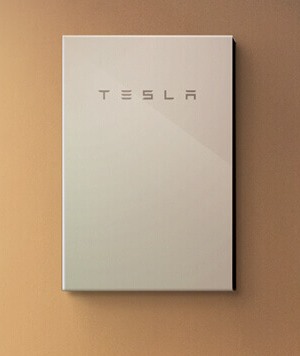Lithium Ion Batteries and Solar Battery Storage
Last Updated: 1st Jan 2025

a Tesla Powerwall 2 Lithium ion battery
Lithium-ion batteries are a newer form of battery storage technology that are are rapidly displacing lead-acid batteries for solar storage in grid-connect scenarios.
This is mainly due to the fact that lithium-ion batteries can be discharged deeper and have a longer lifetime than lead-acid batteries. They will give you around 4,000 – 6,000 cycles at 80% discharge, with some now claiming more. So, assuming good quality they are expected to have a usable lifespan of 13-18 years at this discharge level; although providing decreasing capacity as the years go by. And note that home battery warranties are usually only around 10 years.
Their main drawback, at least for now, is that they are about 50% more expensive than lead-acid batteries for the same amount of storage. This was expected to change rapidly as mass-production of lithium-ion batteries significantly reduced the cost of lithium-ion storage. But this is only just starting to happen for home batteries.
How much will a lithium ion + solar setup cost?
This all depends on the brand of battery you choose to go with. As I have outlined in another article, there are a number of competitors in the lithium-ion battery storage space, with a great deal of variance in pricing-per-kWh.
Everyone seems to be hyped about the Tesla Powerwall, though – so I will use it in this example. A Tesla Powerwall 3 and gateway costs $13,600 as of January 2025.
As a very rough guide, a 6.6kW solar power system costs around the $6,300 mark. If a Powerwall 3 is installed at the same time, its built-in hybrid inverter can be used, which will save some money on the solar installation. But after the cost of installation is added the total comes to around $21,000. And it could be higher depending on the complexity of the installation.
I’ll be the first to admit that $21,000 is a lot of money for the average Australian to find, even if they’re extremely keen on getting solar with battery storage. My recommendation is to go solar now but wait for battery prices to drop before considering adding a battery if your focus is on saving money and those numbers don’t work out for you.
However, Tesla Powerwall isn’t the only game in town and there are home batteries that cost less – but it’s still very important to crunch the numbers. You can check out prices and other specification on our solar battery comparison page.